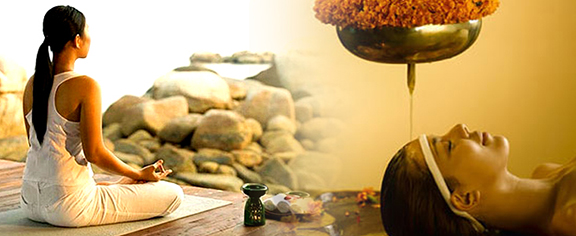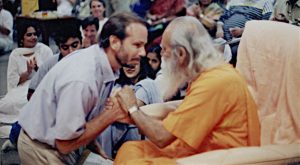 In this interview, Dr. Michael (Muktan) Sullivan, a chiropractor and Ayurvedic doctor, discusses the relationship between chiropractic, Ayurveda and Yoga. He also reflects on all he learned from Swami Satchidananda over the years.
In this interview, Dr. Michael (Muktan) Sullivan, a chiropractor and Ayurvedic doctor, discusses the relationship between chiropractic, Ayurveda and Yoga. He also reflects on all he learned from Swami Satchidananda over the years.
Integral Yoga Magazine: You have been a chiropractic physician for many years. How did you get interested in Ayurveda?
Muktan Sullivan: Actually, I first heard the term “Ayurveda” from Sri Swami Satchidananda (Sri Gurudev) 28 years ago. It piqued my interest. Even when I was in chiropractic school I took two seminars with noted Ayurvedic practitioners Dr. Svaboda and Baba Hari Das. No one in America really knew what Ayurveda was at that point. Dr. Svaboda had just arrived from India. Even after I moved to Virginia, I would read books and study Ayurveda on my own. I would listen to Sri Gurudev speak about Ayurveda.
IYM: Did your background in chiropractic help you when you studied Ayurveda? And what is the relationship between Yoga and Ayurveda?
MS: Yes, chiropractic science gave me a good foundation and knowledge of anatomy and physiology. Yoga and Ayurveda are like brother and sister. Ayurveda understands that the physical, mental and emotional bodies have to be in balance and harmony to pursue spiritual disciples. Ayurveda developed as a result of the changes that happened over the various yugas (ages) in India. As more people became afflicted with physical problems, the Yogis and seers devised a system of medicine to help people return to balance and stay in balance in order to deepen their Yoga practice and spiritual journey.
IYM: Do you see similarities between chiropractic and Hatha Yoga?
MS: Chiropractic is very similar to Hatha Yoga except it’s a passive approach. Someone is doing it to you rather than you doing it yourself. Both chiropractic and Hatha Yoga help us achieve a balanced, easeful, well-working physical body we need for all functions to be normal. I find that the three modalities—chiropractic, Ayurveda, and Yoga— balance each other extremely well.
IYM: What are some Ayurvedic treatments and what kind of benefits have you seen?
MS: Ayurveda consists of panchakarma, the five cleansing techniques and rasayana which are rejuvenation techniques—along with steam, detoxification practices, and diet and lifestyle changes—to purify, tone, and rejuvenate. In my five years of giving treatments I have seen people undergo a profound change in their physical well-being. On a deeper level, they seem to be more in tune with their spiritual self. They often say, “This has been a life-changing experience.”
IYM: How has the practice of Ayurveda been adapted over the years, and particularly in the West?
MS: The word “Ayurveda” means the balance of life or living. It is an ancient, indigenous system that has changed and adapted as people and their lifestyles have changed. Originally, at the time when Ayurveda was developed, a person was born, raised and died within a mile of his or her home. Our lives are very different today, especially in the West. My feeling is that Ayurveda adapts itself to the needs of the population, particularly to the stresses, strains, and ill health created from changes in the culture.
My experience of studying in India and practicing in the West leads me to believe that the West has taken Ayurveda to new places. Western practitioners have translated ancient scriptures into modern books that are more succinct and direct. These texts include chapters, graphs, and references which make the information more accessible. In the traditional system of Ayurvedic education students learned by repeating the sutras orally!
IYM: Do you think something is lost when a traditional or indigenous medicine is adapted in the West?
MS: Not necessarily so. Western culture and people are different than Easterners. Ayurveda here is based on traditional practices but adapted to Western needs. It is similar to how Sri Gurudev adapted the practice of Yoga to the West when he first came to America.
The adaptations are not changes in the basic philosophy but adaptations to fit into the Western lifestyle. One example is that in India, a traditional stay in an Ayurvedic hospital is 28 days. In the West, who has time or money to stay 28 days? So we do it in five to seven days which means clients have to do things on their own before they arrives and then after they leave. So, it’s the same basic program, but done in a more concentrated way.
I am trained in the traditional South Indian Ayurvedic approach, and I try and stay as true as possible to the traditional methods. I sometimes see people doing the Ayurvedic practices but not in a complete way. Lifestyle, diet, Hatha Yoga and meditation are integral to the balance and health of the body.
IYM: Would you talk more about this holistic approach?
MS: At Riverview Spa, we have people stay at Yogaville during their treatments. They participate in Yoga classes, meditation, and the evening programs. They have access to the Light Of Truth Universal Shrine, and to the other shrines in Yogaville, as well as to all Yogaville has to offer. I find this adjunct to be a wonderful boon to people’s experience.
Not only do they get traditional Ayurvedic treatments but they are able to experience the Yogic lifestyle that Sri Gurudev established in Yogaville, which Ayurvedic living is patterned on—arising before sunrise to practice meditation, starting the day with Hatha Yoga, having one’s main meal at midday, eating a natural, vegetarian diet, living in harmony with nature. Their stay here is imbued with chanting, Yoga Sutra classes, and all aspects of spiritual life which brings health to mind, body, and spirit.
IYM: What did Sri Gurudev teach you about Ayurveda?
MS: Sri Gurudev taught us that the goal of Integral Yoga is an easeful, peaceful, and useful life. That is exactly the Ayurvedic model of health. I tell all my patients that my Guru taught me that to have real health and happiness we need a calm, clean mind with sharp intellect, and a useful life full of joy and service for others. These teachings of Sri Gurudev are simple, basic and accessible.
Observing Sri Gurudev over the course of 29 years as his student, I saw that all aspects of his life were in balance—how he ate, rested, and served. He lived an exemplary life. He was more knowledgeable than any Ayurvedic physician. The Integral Yoga lifestyle is both Yoga and Ayurveda combined. Sri Gurudev’s approach is so transformative.
IYM: You had the honor of giving Sri Gurudev Ayurvedic oil massage for several years. What did you learn from that experience?
MS: Sri Gurudev was instrumental in the development of my Ayurvedic massage and panchakarma cleansing techniques. He completely encouraged me, he personally guided me, and he even arranged for my studies at the Ayurvedic hospital in Coimbatore.
He would instruct me directly—making sure I understood what worked or didn’t work. He would give me instructions on types of oils to use, temperature of oil, the speed at which they should be applied, and the basic classical philosophy behind the techniques of the massage.
He told me that in Tamil language, the word for “sesame oil” translates in English as “best of all the best oils” and that is why it is the primary oil used in Ayurveda. In Sri Gurudev’s family home, every Saturday the oil man would come and give everyone in the family an oil bath. From these stories I began to understand the great effects and restorative capacity of the oil treatments.
IYM: Were there any other things he imparted during these sessions?
MS: He spoke about the importance of a pure, sattvic, balanced diet. The greatest lesson I learned was from seeing his body. Sri Gurudev had the skin tone of a 30 year-old person. The tone, relaxation and pliability of his muscles were that of a young man. Just prior to his Mahasamadhi, when I was observing his body during a massage, I thought to myself: “This could be a 30 or 40 year-old man.” There was absolutely no tension in his physical body. He was the picture of Yoga. I truly felt that the massages he allowed me to give him were more for my benefit than his!
I also learned some of the most important lessons from Sri Gurudev by seeing how he dealt with people. He was always able to relate to whomever, with whatever problem, at no matter what level, without judgment and in a way that was compatible and helpful to that person. He was the perfect example of what every health practitioner should aspire to.
About Dr. Michael Sullivan, D.C., D.Ay.

Dr. Sullivan is a diplomate of Ayurvedic medicine. He also has been a chiropractor and a Yoga teacher for over 28 years, and has studied Ayurveda both in India and in the United States. Dr. Sullivan is a popular lecturer on back care, Yoga, meditation, and holistic health. Dr. Sullivan holds workshops on Ayurveda and Yoga at various retreat centers throughout the United States, including Yogaville, Virginia. For more information visit, RiverviewSpa.com.
(photo: Dr. Sullivan with Swami Satchidananda)

